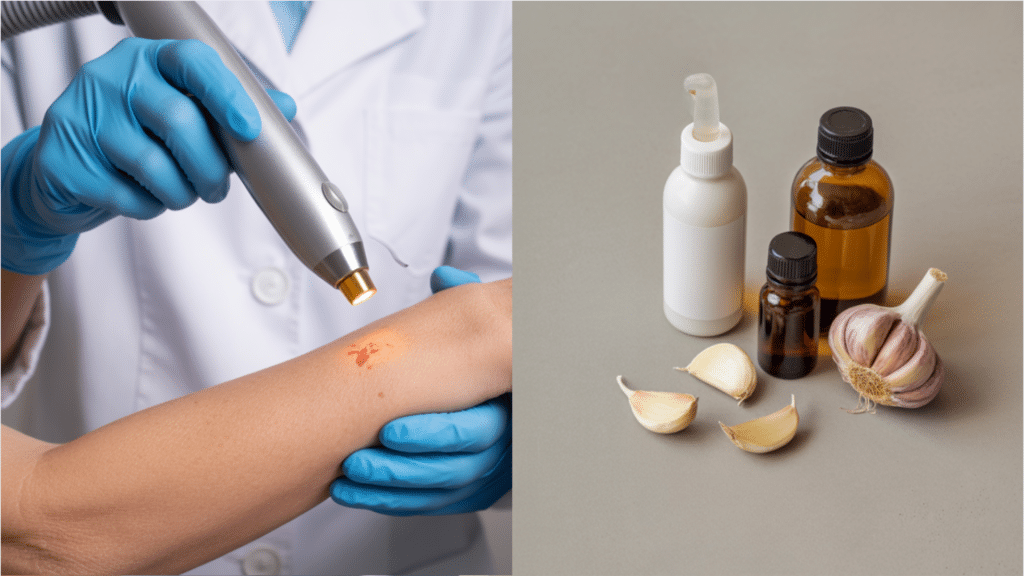Many people consider mole removal for different reasons. Some want to improve their appearance, while others find their moles uncomfortable or irritating.
Sometimes moles change color, size, or shape, which can be concerning.
Getting rid of moles safely requires careful thought. While there are many ways to remove moles, not all methods work well or are safe to try at home.
Professional medical help is often the best choice for mole removal.
If you notice any changes in your moles, it’s important to see a doctor first. They can check if the mole is normal or needs special attention.
This guide will help you understand your options for safe and effective mole removal.
Understanding Skin Moles
Moles are common dark spots that appear on your skin. They form when skin cells grow in clusters instead of spreading out evenly. Most people have between 10 and 40 moles on their bodies.
There are different types of moles. Some are flat and smooth, while others stick up from your skin. Moles can be brown, black, or even pink in color.
You should watch your moles for changes over time. See a doctor if a mole changes shape, gets bigger, or develops an uneven border.
Also, pay attention if it changes color or starts bleeding, or itching.
Professional Medical Procedures for Mole Removal
Medical professionals use several proven methods to safely remove moles. Each procedure has specific steps and works best for different types of moles.
1. Surgical Excision
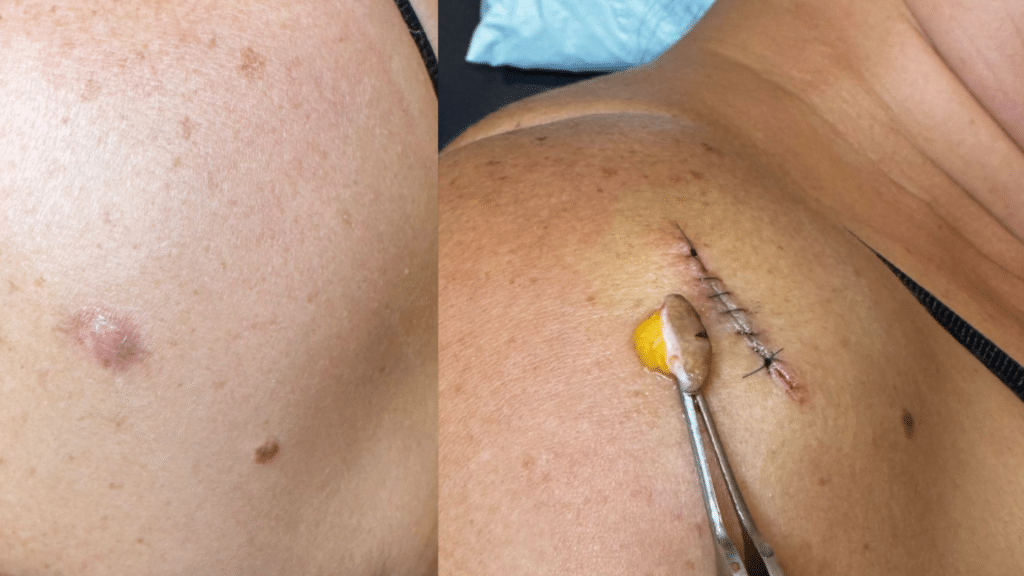
Step 1: Apply Numbing → Step 2: Position Blade → Step 3: Shave Mole Flush → Step 4: Control Bleeding → Step 5: Apply Dressing → Step 6: Monitor Healing
This method involves cutting out the entire mole with a small knife called a scalpel. The doctor also removes a small area of healthy skin around the mole. Then they close the area with stitches.
Doctors use this method for larger moles or ones that might be cancerous. It completely removes the mole, so it won’t grow back. The removed tissue can be tested in a lab to check for cancer.
The healing process takes about two weeks. You might have a small line-shaped scar, but doctors use special techniques to make it as small as possible.
2. Shave Excision
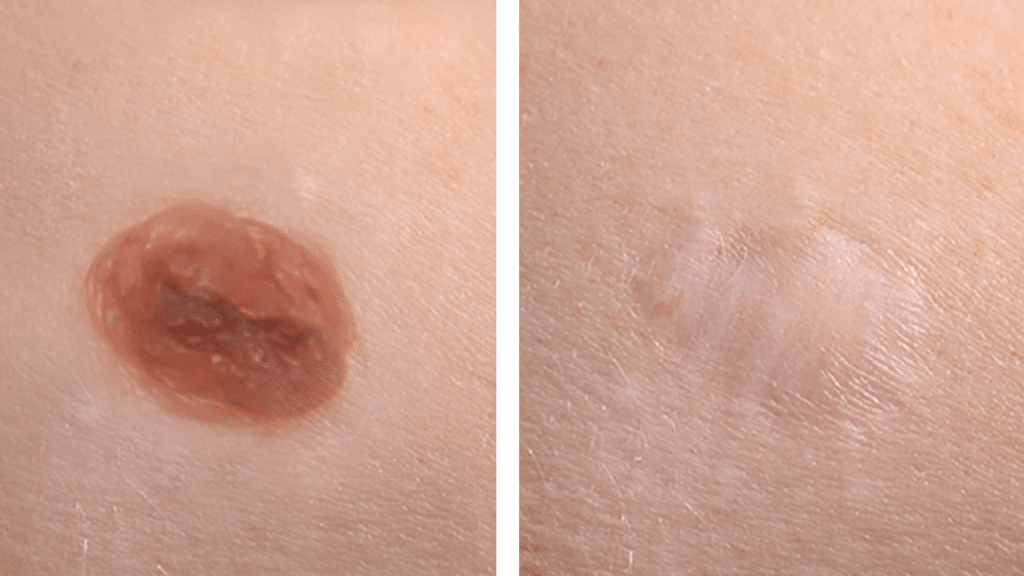
Step 1: Apply Numbing → Step 2: Position Blade → Step 3: Shave Mole Flush → Step 4: Control Bleeding → Step 5: Apply Dressing → Step 6: Monitor Healing
With this method, the doctor uses a special blade to shave the mole off at skin level. It’s like shaving with a razor, but much more precise and safe.
This works best for smaller, raised moles that aren’t cancerous. The procedure is quick and doesn’t require stitches. Most people heal within a week.
The downside is that some mole cells might remain under the skin. This means the mole could grow back later, though it’s usually smaller than before.
3. Laser Removal

Step 1: Clean Area → Step 2: Apply Eye Protection → Step 3: Target with Laser → Step 4: Multiple Pulses → Step 5: Cool Skin → Step 6: Schedule Follow-up
Laser treatment uses focused light to break down the dark color in flat moles. The laser targets the pigment without harming the surrounding skin.
This method works well for small, flat moles on the face. It leaves minimal scarring and heals quickly. Most people need 2-3 treatment sessions.
However, lasers don’t work for all types of moles. They can’t remove deep moles or ones that might be cancerous. Your doctor will determine if laser treatment is right for your mole.
4. Cryotherapy (Freezing)
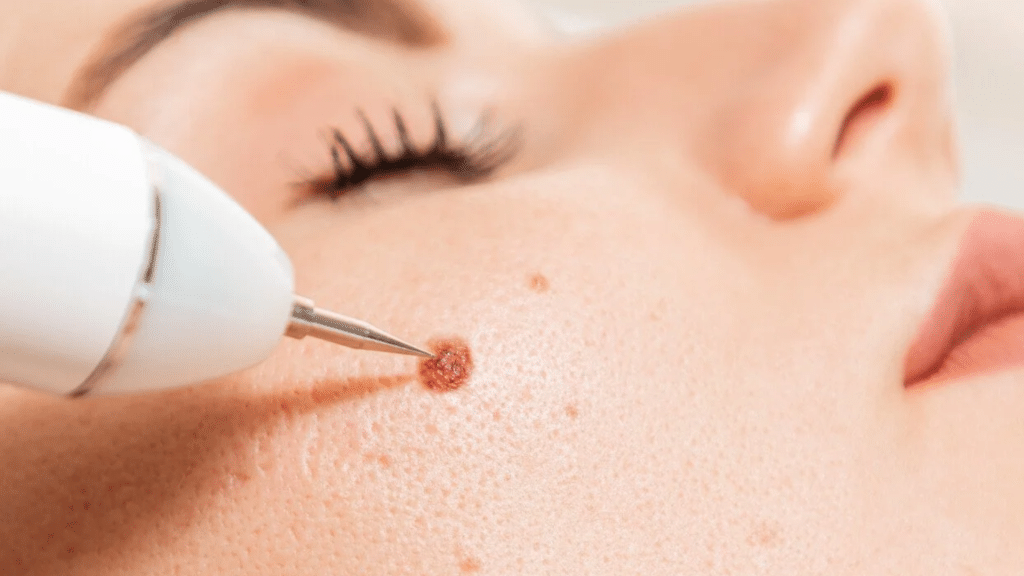
Step 1: Clean Mole → Step 2: Apply Liquid Nitrogen → Step 3: Wait for Freezing → Step 4: Remove Applicator → Step 5: Allow Blistering → Step 6: Natural Healing
This procedure uses extremely cold liquid nitrogen to freeze the mole. The freezing destroys the mole cells, causing them to fall off over time.
Cryotherapy works best for raised moles and skin tags. It’s a quick procedure that takes just a few minutes. The treated area might blister and then scab over before healing.
This method isn’t suitable for flat moles or suspicious ones that need testing. The frozen tissue can’t be examined under a microscope.
5. Radiofrequency and Electrosurgery
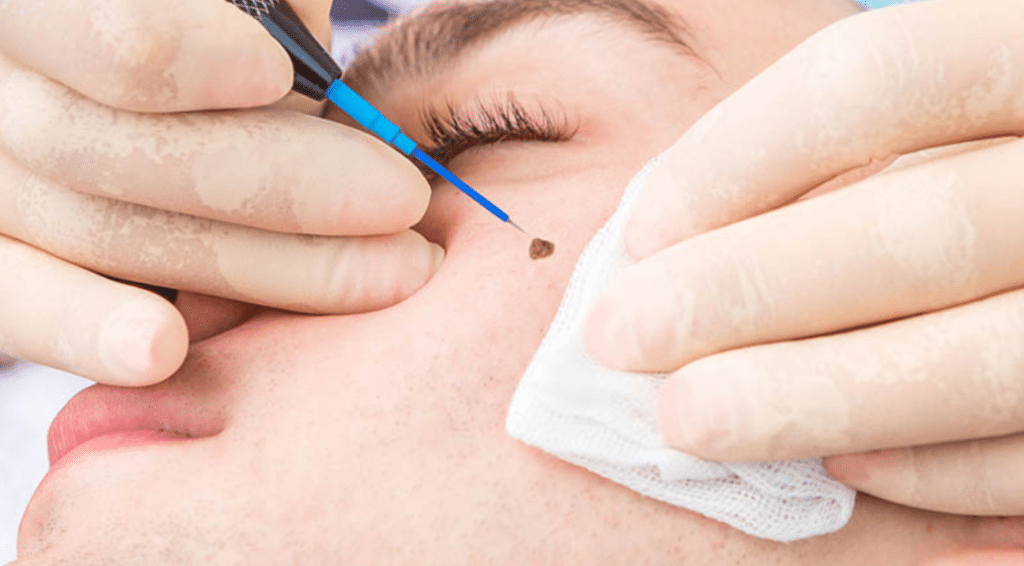
Step 1: Numb Area → Step 2: Set Equipment → Step 3: Apply Energy → Step 4: Layer Removal → Step 5: Stop Bleeding → Step 6: Dress Wound
These methods use heat or electrical current to remove moles. The energy burns away the mole tissue layer by layer.
Doctors often choose these techniques when they want good cosmetic results. The controlled burning helps reduce bleeding and can minimize scarring.
These procedures work well for raised, non-cancerous moles. They’re often done in the doctor’s office with local numbing medicine.
Safety, Aftercare, and Monitoring
Professional mole removal follows strict safety rules. Doctors use sterile tools and clean techniques to prevent infection.
They also provide detailed instructions for caring for your skin after the procedure.
After removal, you’ll need to keep the area clean and dry. Your doctor might prescribe an antibiotic cream to prevent infection. Follow all aftercare instructions to ensure proper healing.
Any suspicious moles removed by surgery get sent to a lab for testing. This helps doctors rule out skin cancer and ensures you get the right treatment if needed.
Home Remedies and DIY Mole Removal Methods
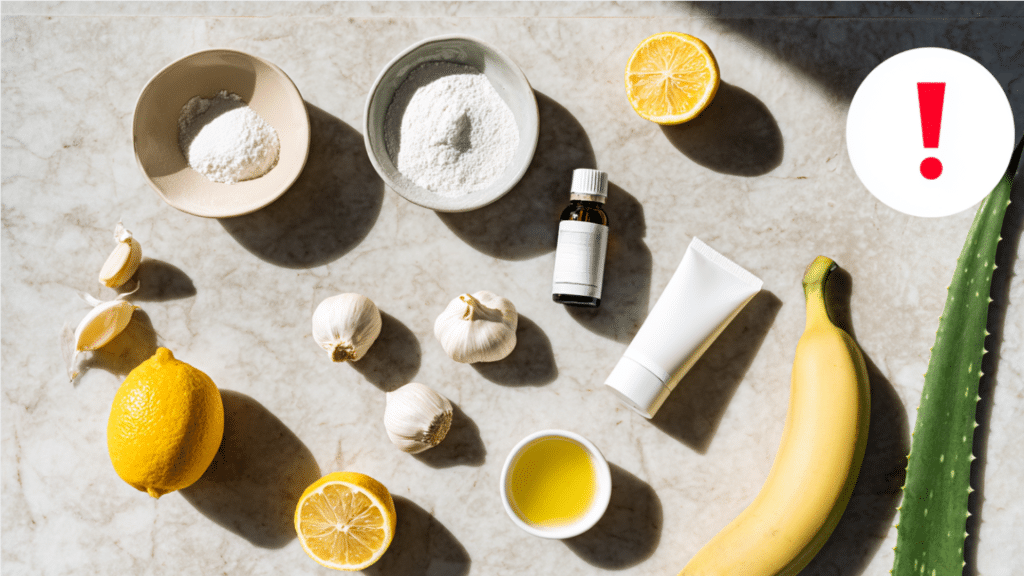
Many people search for natural ways to remove moles at home using common household items. While these methods are popular, it’s important to understand their limitations and potential dangers.
1. Popular DIY Approaches
Many people try home methods to remove moles naturally. Common household items used include garlic, apple cider vinegar, and tea tree oil. Others try iodine, castor oil, baking soda, or lemon juice.
Some people use banana peels, hydrogen peroxide, or aloe vera on their moles. There are also over-the-counter creams sold online that claim to remove moles at home.
These methods are popular because they seem simple and cost less than professional treatment. However, there’s no scientific proof that any of these home remedies actually work.
2. Effectiveness and Risks of Home Methods
Home remedies rarely remove moles completely. They might fade the color slightly or make the mole look smaller on the surface. But the deeper mole cells usually remain untouched.
Trying to remove moles at home carries serious risks. You could develop an infection, especially if you use dirty tools or harsh chemicals.
The biggest danger is missing a cancerous mole. If you try to treat a dangerous mole at home, you could delay getting proper medical care.
This delay might allow cancer to spread to other parts of your body.
3. Over-the-Counter and Online Removal Creams
Many creams sold online promise to remove moles safely at home. However, the FDA hasn’t approved any of these products for mole removal.
They often contain harsh acids that can damage your skin.
These creams can cause deep burns and create permanent, unsightly scars. Some people need plastic surgery to fix the damage caused by these products.
The chemicals in these creams aren’t designed for home use. Without proper medical supervision, you can seriously harm your skin and health.
Risks of Home Procedures
Home mole removal carries serious medical risks that many people don’t consider. Understanding these dangers can help you make safer choices for your skin health.
- Myth-based methods: Over 90% of popular DIY treatments have no scientific backing and are based on old wives’ tales.
- Severe scarring: Deep burns and keloid scars often develop, creating marks much worse than the original mole.
- Dangerous infections: Dirty tools and harsh chemicals can cause serious skin infections requiring hospital treatment.
- Cancer detection delays: Treating a cancerous mole at home can mask warning signs and allow cancer to spread undetected.
- Emergency room visits: Medical professionals frequently treat patients injured by home mole removal attempts.
- Higher costs: Fixing damage from failed home treatments usually costs thousands more than professional removal.
Comparing Procedures: Professional vs. DIY
Choosing between professional and home mole removal can be confusing. This comparison table shows the key differences to help you make an informed decision.
| Aspect | Professional Removal | Home/DIY Removal |
|---|---|---|
| Effectiveness | High success rates with complete removal | Low success rates, often incomplete |
| Safety | Sterile tools and medical expertise | High risk of infection and complications |
| Scarring Risk | Minimal with skilled practitioners | High risk of permanent scarring |
| Cancer Testing | Lab analysis available for suspicious moles | No pathology review is possible |
| Cost | Higher upfront, but medically sound | Lower initial cost but hidden medical risks |
| Recovery Time | Predictable healing with follow-up care | Unpredictable results and healing |
Note: While DIY methods may seem cheaper initially, complications from failed home treatments often result in higher overall costs and more extensive medical intervention.
Conclusion
Any mole that changes or concerns you needs professional evaluation. Don’t try to diagnose or treat suspicious moles yourself. A dermatologist can quickly determine if a mole needs attention.
Many safe and effective medical options exist for mole removal. Your doctor can recommend the best method based on your specific situation and health needs.
Home remedies and DIY methods aren’t supported by medical evidence. They carry significant risks, including infection, scarring, and missed cancer diagnoses.
Always consult your healthcare provider before choosing any mole removal method.
Have you had experience with mole removal, or do you have questions about the process? Share your thoughts and experiences in the comments below to help others make informed decisions about their skin health.
Frequently Asked Questions
Can You Remove a Mole Yourself at Home?
Medical experts strongly advise against removing moles at home. It’s unsafe and can lead to serious complications. Always see a qualified doctor for mole removal.
How Much Does Professional Mole Removal Cost?
The cost varies depending on the method used, the size of the mole, and whether lab testing is needed. Simple procedures might cost a few hundred dollars, while complex surgeries cost more.
Will Insurance Cover Mole Removal?
Insurance often covers removal when it’s medically necessary. This includes moles that are cancerous, irritating, or changing. Purely cosmetic removals usually aren’t covered by insurance.

